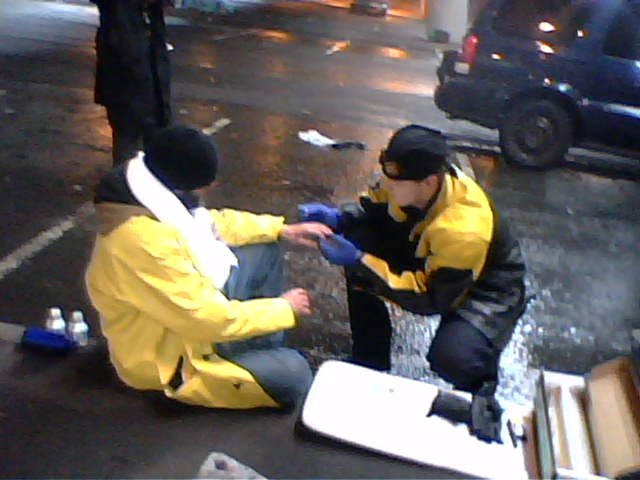 Article no longer available on source site
Article no longer available on source site
This crime fighter may be silent, but he’s far from being deadly.
By Kimiko Martinez
A young man stands on the south side of the Soldiers’ and Sailors’ Monument. The ominous stone memorial looms above him as he waits on the top steps dressed in black pinstriped pants and vest, a pressed black button-down shirt, a black felt hat and silver gloves.
This man, who refuses to reveal his real name when in costume, carries a silver-topped cane. A silver mask hides any expression, revealing little more than soft brown eyes.
While his costume does plenty to conceal his identity, it belies a fit physique. His stealth movements, inspiration for his superhero name Mr. Silent, evidence years of martial arts.
Above him, “To Indiana’s Silent Victors” is etched in the limestone and sculptures representing men who’ve fought for justice adorn the 284-foot tall shrine.
It’s an interesting parallel.
“Hey, what are you?” a passerby asks. “A mime?”
“No,” he responds, handing him a card that reads simply: “Mr. Silent,” along with the Japanese characters for “quiet repose” and an e-mail address.
“Hey, you’re supposed to be Mr. Silent; you just talked,” the man says, looking up from the card. “So what do you do?”
“I fight crime.”
The man in black
Mr. Silent gets this a lot.
“People are always asking: ‘Are you a mime?’ or ‘What are you guys doing?’ ” the 27-year-old tells me. Usually he has his partner Doktor DiscorD along. Not surprisingly, two men in costumes walking around Downtown incite odd reactions.
Mr. Silent just brushes it off. People aren’t accustomed to seeing superheroes patrolling the city . . . yet. But since the duo began this “experiment,” as Mr. Silent calls it, the superhero trend has started to catch on. Others have e-mailed the duo asking how they can join and superheroes have popped up in other cities worldwide, he said.
“A lot of people have told us that they’ve been waiting for something like this to happen,” he said. “Like there was a hole in them; they always wished that something like this was real.”
Certainly people are familiar with the likes of Superman and Batman. Comic book characters are practically ingrained in American culture, as evidenced by the slew of movies released each year. X-Men, Superman and “My Super Ex-Girlfriend” are all on the summer movie circuit. But in real life?
“People have tried to invent time machines because of H.G. Wells or teleporters because of Star Trek,” Mr. Silent said. “It almost makes you wonder why no one has done this before.”
After discussing the idea for quite some time, he and Doktor DiscorD decided to hit Indianapolis streets about a year ago.
“It was just a big experiment to see how people would react,” he said. “We’ve gotten some good responses.”
Unlike Bruce Wayne, Mr. Silent’s alter ego isn’t a billionaire. He has a full-time job to tend to, so he only makes it out about once per week, cruising the alleys of Downtown after dark, looking to help where needed.
Although he isn’t afraid to throw a punch, Mr. Silent is quick to point out that he prefers to avoid confrontations. “We’re really more towards the hero aspect than the vigilante thing,” he said.
Helping people is the focus, even if it means handing out heat packs to the homeless in the winter when hard-pressed to find something to do.
“You don’t have to have superpowers to be a superhero,” Mr. Silent said. “We see heroes every day. We’re just the ones with the costumes on.”
Mr. Silent speaks up to answer our burning questions
So what does it take to become a superhero?
I think the prerequisites are a good imagination and not going overboard. I had this friend who wanted to join, but I think he was using it as an excuse to hurt people.
What’s your superpower?
We’re more along the Batman line. We don’t have any real powers. Although I do have this uncanny ability to spin for a long time without getting dizzy. If there ever comes a time where I can fight crime by spinning, I’ll be set.
Tell me about your name.
Doktor DiscorD is more outgoing than I am, so at first it was an excuse to not have to say anything. But now it’s more because of the way I move. I’m very quiet when I walk, pretty stealthy.
What’s your kryptonite?
Bullets, I’d imagine. Or knives. Anything that can do damage to a human can do damage to me. I don’t wear a Kevlar vest or anything.
Batman or Superman?
I’d say Superman, just because of his ideologies — freedom and all that stuff. Plus, he was the first superhero I was introduced to. I used to hum his theme song when I was running around as a kid.
Lois Lane or Mary Jane?
Lois Lane seems more the powerful type, so I’m going to say Lois Lane. Mary Jane is always getting herself in trouble and needing to be rescued.
What super-toy/tool would you most want?
Maybe grappling hooks, the kind that Batman had.
Marvel or DC Comics?
DC. I’m a big Grant Morrison fan. And they tend to be more superhero-oriented.
What do you get out of superhero life?
Wearing the mask has actually kind of changed me. It’s kind of like the mask took over. I developed a responsibility to do good things because I had the mask on. I’ve started to want to help out at soup kitchens and do things that never crossed my mind before. I feel like I can do more.
In real life, I’m pretty shy, kind of introverted. But when I have the costume on, it’s like I’m a completely different person. The mask kind of becomes like a shield. And now, (the two sides of my personality) have kind of meshed into each other.


